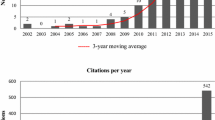Abstract
Since the late 1980s, young people aged 18–34 have increasingly stated that their primary reason for increasing their saving rate has been to protect themselves against uncertain future times. The rate of increase in “precautionary” savings exceeds that of all other age groups, and has occurred against a backdrop of declining real income, a tepid economic recovery from the Great Recession of 2008–09, a tightened credit environment, and changing household demographics. This study considers the impact of these and other elements on young adults’ decisions to save for precautionary purposes, and considers what possible impacts these developments might have for broader consumption and production trends in the U.S economy.












Similar content being viewed by others
Notes
Although there are approximately 5000 families interviewed for the SCF during any given survey year, there are actually 25,000–30,000 observations contained within the SCF survey database. For many purposes, one must consider the sampling error of SCF estimates. Because detailed information on the sample design cannot be released and because of the complexity of the SCF design, users cannot apply some of the standard procedures for variance estimation. A set of sample replicates, five per observation, has been created with bootstrap techniques, and analysis weights have been computed independently for each replicate. All estimates provided in this analysis are based on weighted samples using the replicate weights provided in the triennial SCF data releases.
References
Aguiar, Mark and Mark Bils. 2015. Has consumption inequality mirrored income inequality? American Economic Review 105(9):2725–2756.
Amromin, Gene and Leslie McGranahan. 2015. The great recession and credit trends across income groups. American Economic Review 105(5):147–153.
Ando, Albert and Franco Modigliani. 1963. The ‘life-cycle hypothesis of saving: aggregate implications and tests. American Economic Review 53(1):55–84.
Bogan, Vicki L. 2015. Household Asset Allocation, Offspring Education, and the Sandwich Generation. American Economic Review 105(5):611–615.
Chen, M. Keith. 2013. The Effect of Language on Economic Behavior: Evidence From Savings Rates, Health Behaviors, and Retirement Assets. American Economic Review 103(2):690–731.
Henry, LaVaughn. 2015. America’s Changing Tastes. Federal Reserve Bank of Cleveland Economic Commentary 2015–08.
Knoll, Melissa A. Z., Christopher R. Tamborini, and Kevin Whitman. 2012. I Do Want to Save: Marriage and Retirement Savings in Young Households. Journal of Marriage and Family 74:86–100.
McCarthy, Jonathan and Charles Steindel. 2007. Housing Activity and Consumer Spending. Business Economics 42(2):6–21.
U.S. Census Bureau. 2015. Millennials Outnumber Baby Boomers and Are Far More Diverse. Census Bureau Report CB15–113.
Author information
Authors and Affiliations
Corresponding author
Rights and permissions
About this article
Cite this article
Henry, L.M. Are Young People Becoming More Risk Averse? An Analysis of Factors Contributing to the Rise in Precautionary Savings Among Young Adults. Bus Econ 52, 32–40 (2017). https://doi.org/10.1057/s11369-017-0020-x
Published:
Issue Date:
DOI: https://doi.org/10.1057/s11369-017-0020-x




